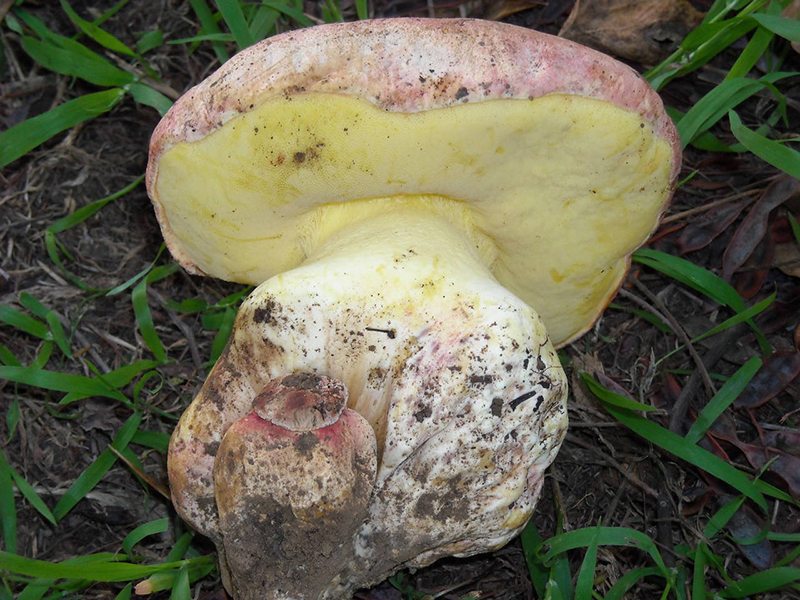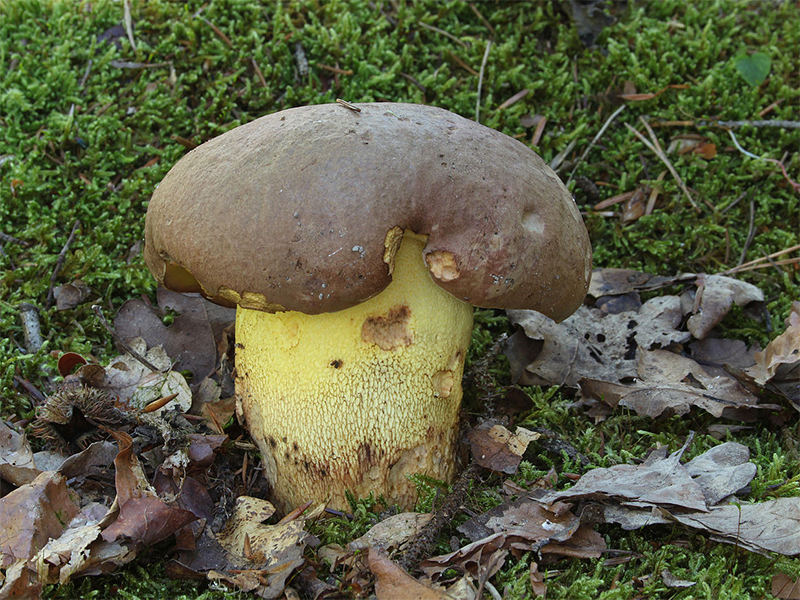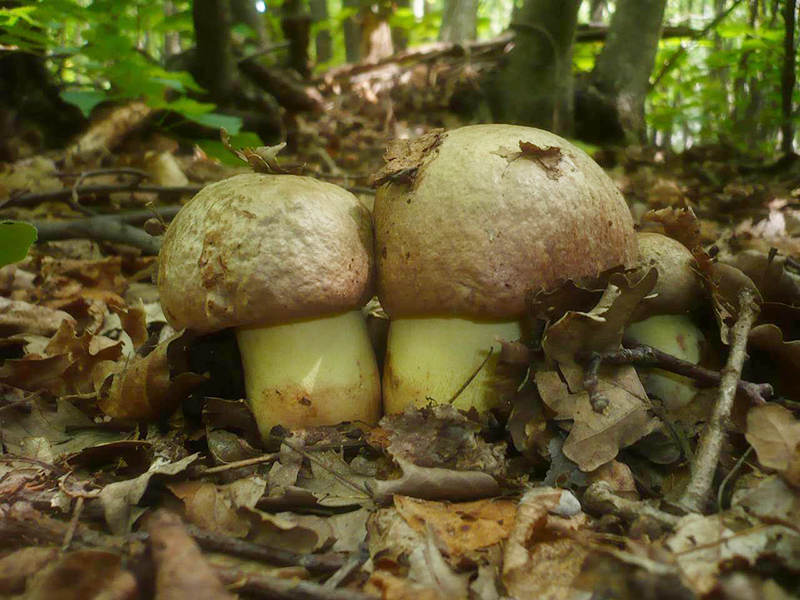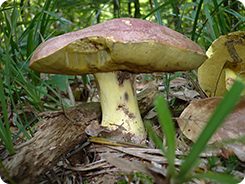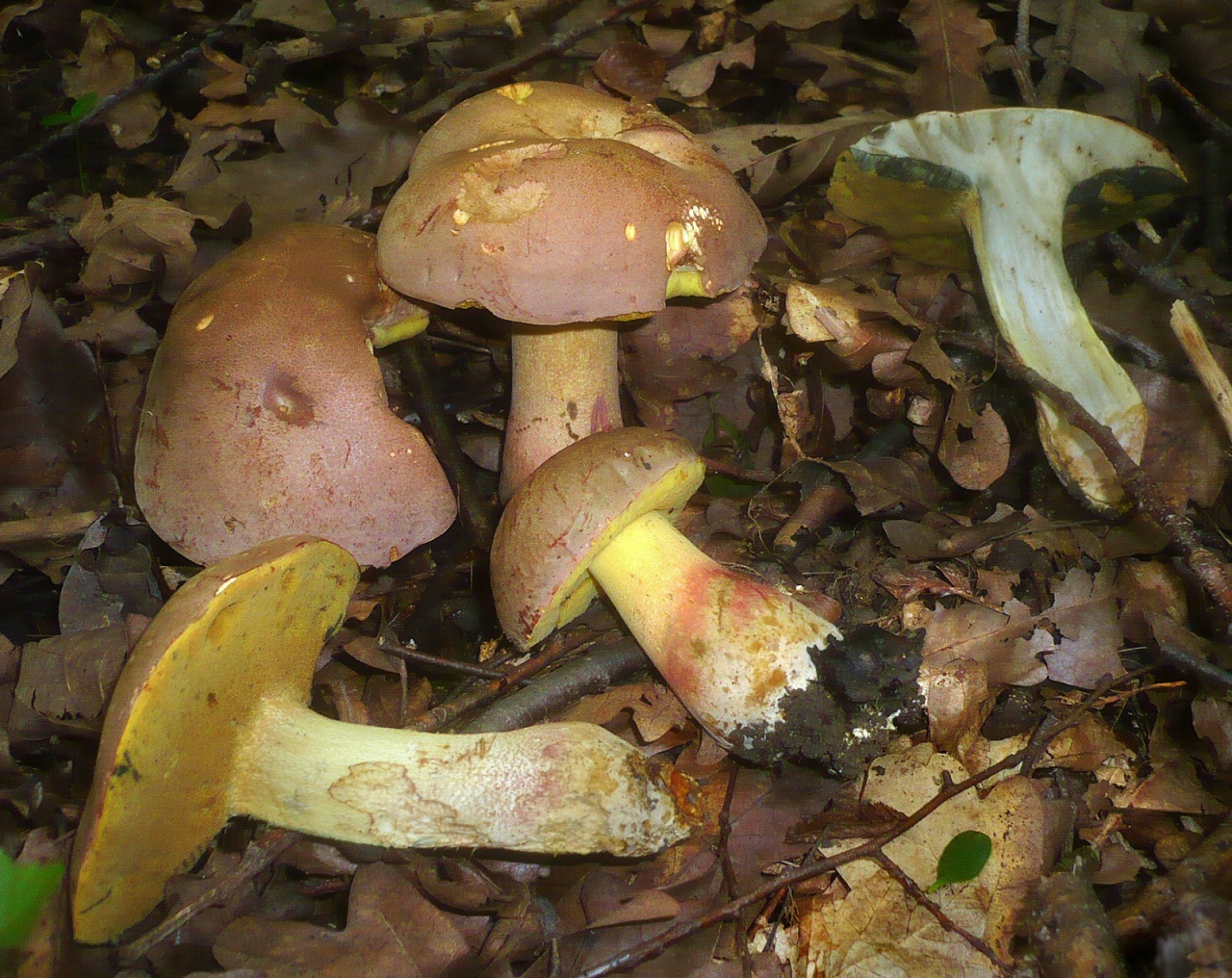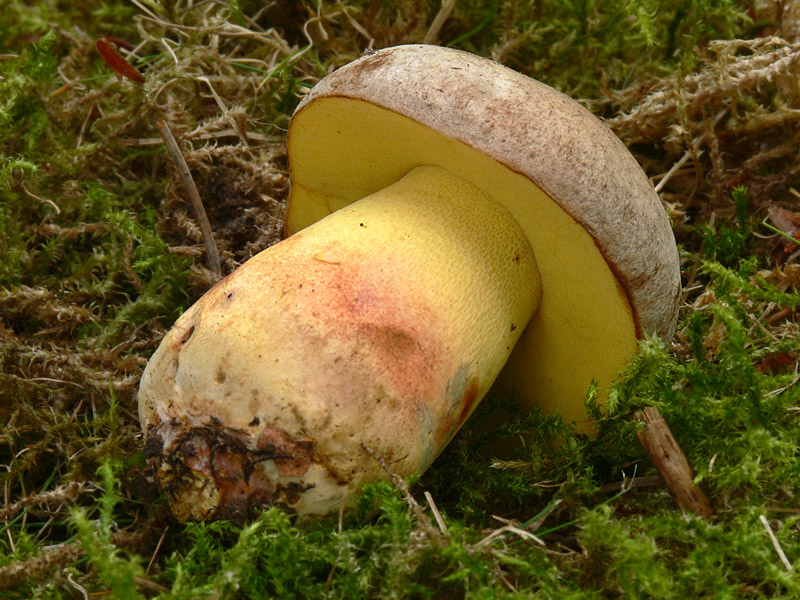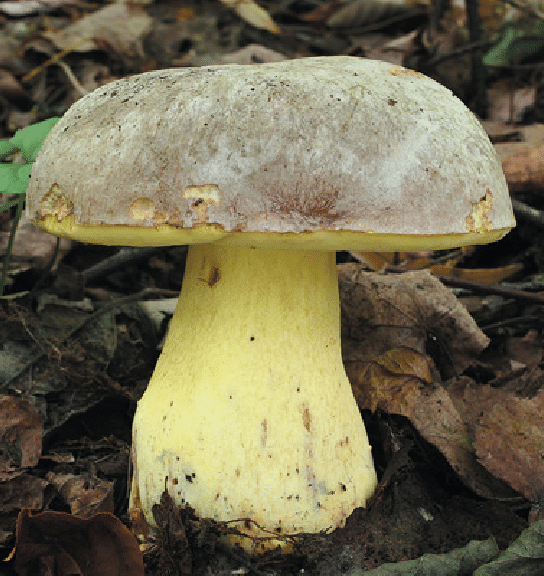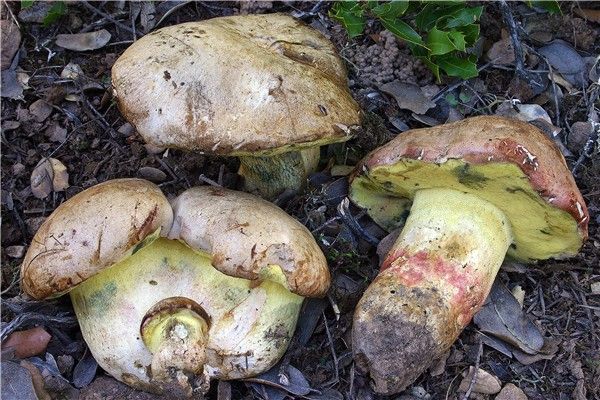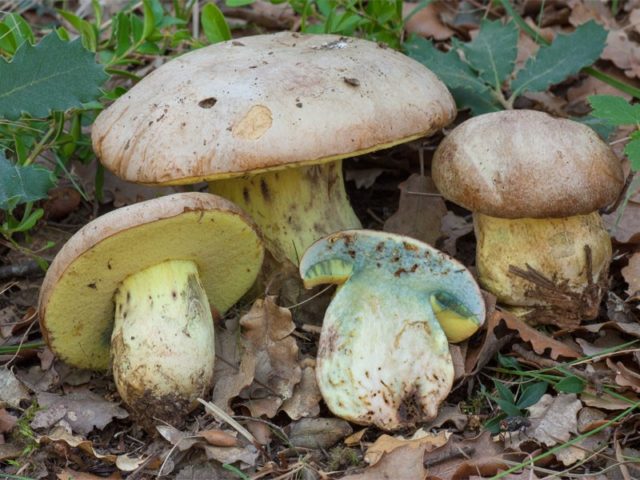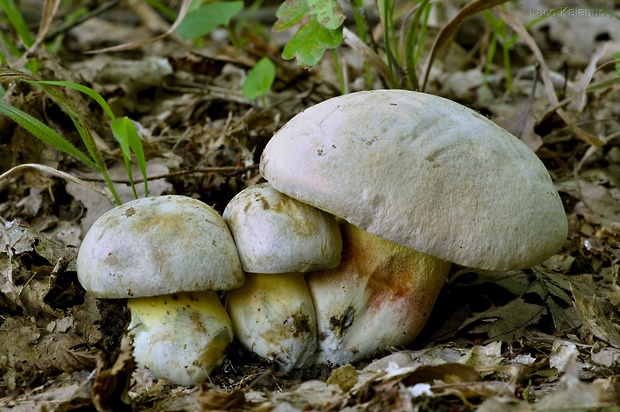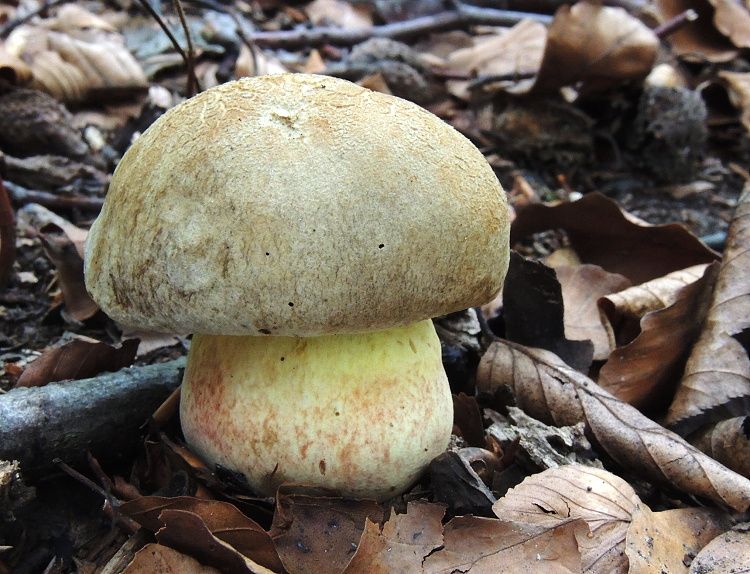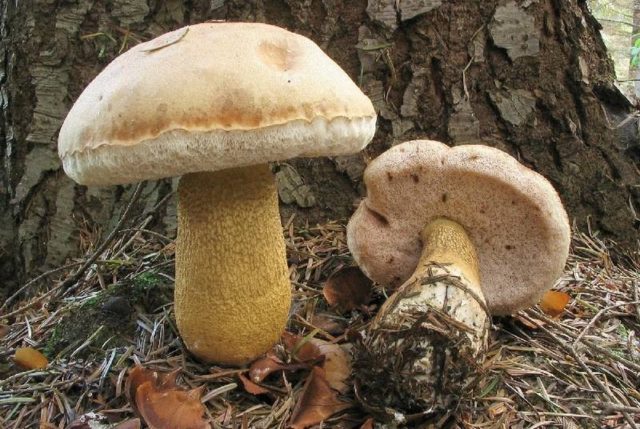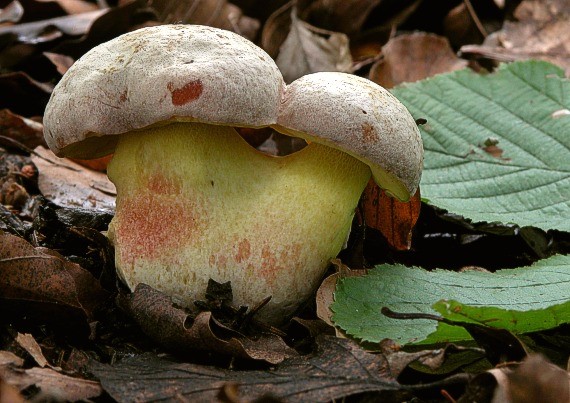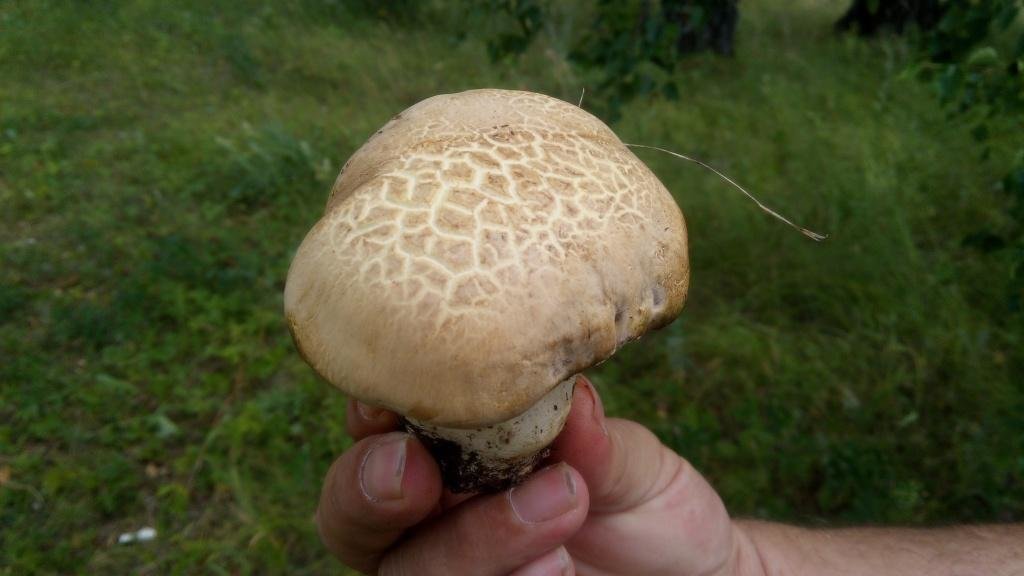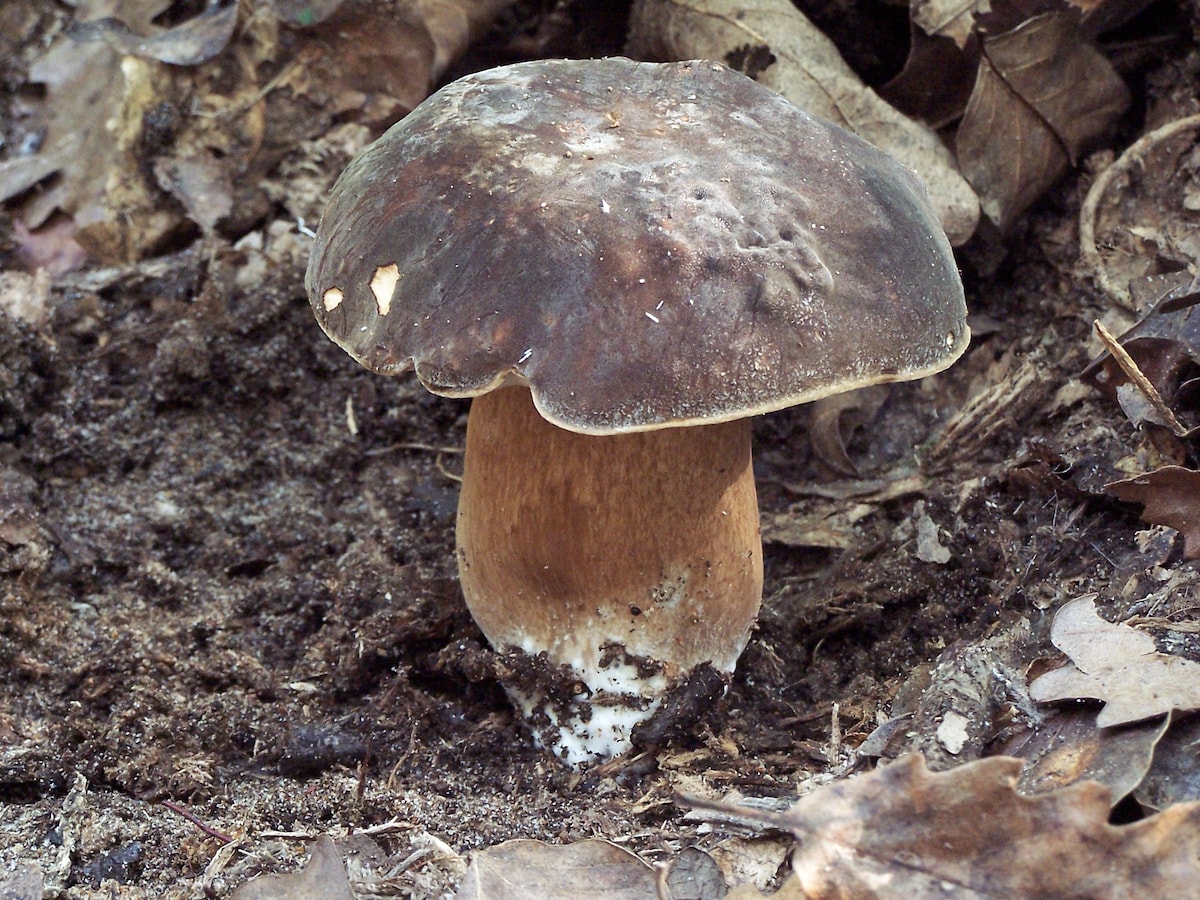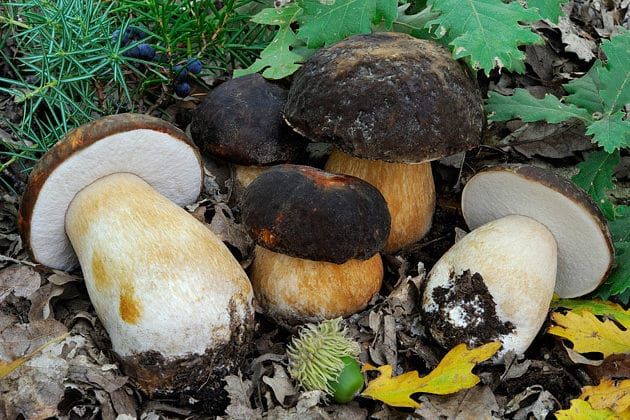Description of boletus adnexa
The diameter of the boletus cap is 7-20 centimeters. The shape of the cap in young specimens is semicircular, becoming convex over time. The cap has a thick crumb up to 4 centimeters in size. The top skin is practically not removed from the cap. The color of the cap is red-brown, yellow-brown or brown-brown. At first, the surface of the cap is velvety, pubescent, matte, but with age it becomes bare, slightly fibrous.
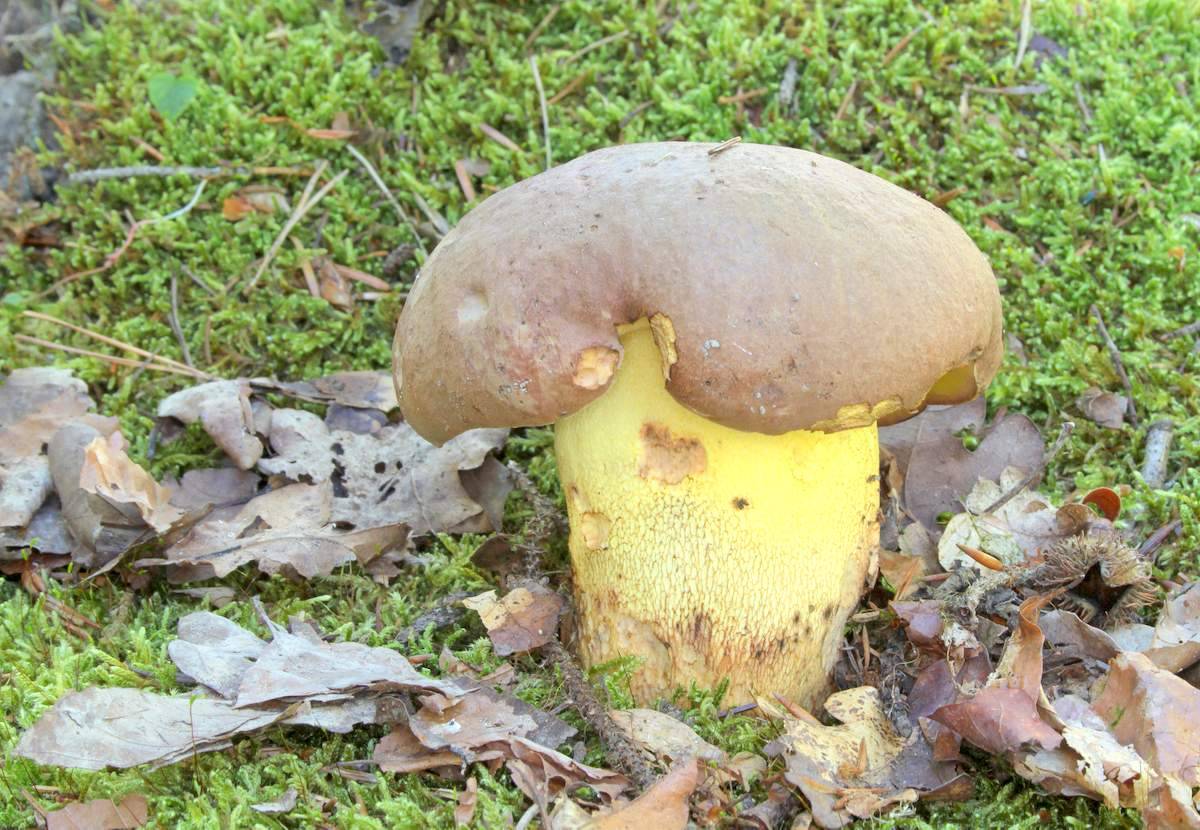
The pulp is dense, rich yellow. At the base of the leg, the color of the pulp is pink-brown or brown. In the cap above the tubes, the flesh is blue, its taste and smell are pleasant. The pores are small, rounded, at a young age they are golden yellow, then golden brown. When pressed, the pores become bluish. Spores are smooth, ellipsoid-fusiform, honey-yellow in color. Spore powder of olive-brown hue.
The leg is 6-12 centimeters long and 2-3 centimeters in diameter. There is a mesh on the leg, it disappears with age. The color of the leg is lemon yellow, at the bottom it becomes red-brown in color. Its shape is clavate or cylindrical, the base of the leg is pointed. When touched, the leg turns blue.
Distribution of boletus adnexa
Boletus boletus are rare mushrooms. They grow mainly in colonies. Fruiting from June to September. Boletus adnexa are found mainly in areas with a moderately warm climate. They grow in mixed and deciduous forests. These mushrooms prefer calcareous soil.

The similarity of boletus maiden with other mushrooms
Boletus adventitious are similar to semi-white mushrooms, but the latter are distinguished by a light ocher-colored cap, a black-brown lower part of the stem and a carbolic odor. Also boletus girlish outwardly resembles edible boletus semispidatochny with white pulp, which is extremely rare in spruce mountain forests.
Other mushrooms of this genus
The false satanic mushroom or boletus is a conditionally edible mushroom. The hat is 5-10 centimeters in diameter, but can reach 20 centimeters. At first, its shape is semicircular, and then it becomes convex-outstretched, often with sharp protruding edges. The color of young mushrooms is milky-coffee or grayish, and in adults it becomes dark pink or brown with a reddish tint. The pulp is dense, thick, blue. The height of the leg is 4-8 centimeters with a thickness of 2-6 centimeters. The shape of the leg is cylindrical, the lower part is narrowed. The color of the leg is yellowish with red or reddish-brown spots, its lower part is brownish.

The false satanic mushroom is a fairly common species among the sick. These mushrooms grow in oak forests. They bear fruit from November to January. They grow in groups. Wolf boletus is eaten after preliminary boiling for 10-15 minutes.
Boletus Fechtner is an edible mushroom. The diameter of its cap is 5 to 15 centimeters. Its shape is hemispherical, but over time it becomes flat. The color is silvery white or pale brown. The height of the leg is 4-15 centimeters, with a thickness of 2-6 centimeters, with a thicker lower part. The color of the leg is red-brown, there may be a mesh pattern.
Boletus Fechtner grows on calcareous soil. These mushrooms are found in deciduous forests, in the Caucasus and the Far East. Fruiting time is from June to September. Fechtner's boletus can be consumed salted, fresh and canned; in terms of taste, they belong to the 3rd category.

Borovik subordinate (Borovik maiden)
Boletus subordinate
– Boletus appendiculatus
In another way, it is called the Ovary, the girl's Borovik, the brown Borovik - yellow, the shortened Borovik, or the reddish Borovik.
External features
Mushroom cap
The caps of these boletus mushrooms reach a diameter of 7 to 20 cm and a thickness of about 4 cm. In young mushrooms they are semicircular, matte and fleecy - velvety, in more mature specimens they are convex and smooth, covered with tightly adhered skin.
Hats are painted in brown - yellow, brown - red and brown - brown tones.
The bottom is decorated with a golden yellow (in young mushrooms), later - a golden brown tubular mass. If you press on it, it turns greenish blue.
Boletus girlish is endowed with dense bright yellow pulp that turns blue when cut.
Ripe mushrooms form smooth, elongated honey-colored spores in olive-brown spore powder.
Stipe
Legs of the Borovik subordinate, which have the shape of a club or a cylinder, reach 20-30 mm in thickness and 6-12 cm in height. The surface is covered with a mesh that disappears in mature mushrooms, and is colored lemon-yellow, the bottom becomes brown-red.
The pulp, slightly blue when touched, has a yellowish tint, closer to the ground - brownish or brownish-pink.
Growing places
Shortened boletus prefers moderately warm climatic conditions, limestone soils, mixed and deciduous forests with beech, hornbeam and oak. Sometimes found in mountainous areas - next to fir trees. Often found in southern European countries.
Fruiting is rare, in small clusters, occurs in June - September.
Similar species
Edible
-
Half white mushroom
... It differs from the girlish Borovik in a light ocher hat, a brown - black base of the leg and the smell of carbolic acid. -
Borovik semi-adherent
... Differs in white flesh and places of growth: prefers mountain spruce forests.
Poisonous
-
Root boletus
... The mushroom is distinguished by a light color of hats and thicker legs. -
Boletus inedible
... It is characterized by a brighter leg and a tendency towards acidic fertile soil.
The edibility of the mushroom
Borovik adnexa (Borovik maiden) exudes a pleasant mushroom aroma and has an excellent taste. It can be boiled, fried, dried, and canned.
Boletus subordinate (lat. Boletus appendiculatus
) - tubular, edible mushroom of the genus Borovik (Boletus
) families of boleths (Boletaceae
). A rare mushroom that grows from June to September, in deciduous and mixed forests.
Hat
The diameter of the cap of the Borovik subordinate is from 70 to 200 mm. At a young age, the cap of the mushroom has a semicircular shape. With age, the fungus becomes convex. The surface is velvety, matte, becomes naked with age, slightly longitudinally fibrous. The skin is practically not removed. Borovik's cap is yellow-brown, red-brown and brown-brown in color.
The tubules are dense, up to 40 mm in length. The pores are small and rounded. The color of the tubes in young mushrooms is golden yellow; with age, the mushroom becomes golden brown. When pressed, they acquire a bluish-greenish tint.
Spore powder, spores
Spores are smooth, ellipsoid-fusiform. The size of the spores is 10-15 x 4-6 microns. They are honey-yellow in color. The spore powder is olive-brown.
Leg
Leg height from 60 to 120 mm, diameter from 20 to 30 mm, cylindrical or club-shaped. The base of the stem is conically pointed, rooted in the ground. The leg of the boletus is mesh, with the age of the fungus the mesh pattern disappears. The color of the leg is closer to the cap of lemon-yellow color, to the bottom it is red-brown.
Pulp
The pulp is firm, intense yellow. At the base of the peduncle is brownish or pinkish-brown. Has a pleasant mushroom taste and aroma. Turns blue on the cut.
When and where it grows
Rare mushroom. Prefers to grow in groups of 3 to 7 pcs. The boletus is found mainly in deciduous and mixed forests from June to September. Likes to grow in regions with warm temperate climates. Forms mycorrhiza with oaks, hornbeams and beeches. Also noted in the mountains among the fir trees. Attachment to calcareous soil is noted in the literature.
Eating
Delicious edible mushroom. Suitable for all types of processing.
The boletus mushroom is one of the most common species of the Boletov family. Among the most common types of boletus are white oak mushroom (sometimes it is called net boletus), bronze boletus and girlish boletus. All these mushrooms have long been used for food, and nowadays they are delicacies, since the halo of their distribution has significantly decreased.
Below you will find a photo and description of the boletus mushroom, information about the places of their growth and recommendations for the use of these mushrooms in cooking.
Borovik: general characteristics
Boletus is a mushroom of the Boletaceae family (Latin Boletaceae). Experienced mushroom pickers and mycologists among themselves call all representatives of the species pains. Looking ahead, let's say that the boletus has enough relatives: in total, there are up to three hundred subspecies of the family.
They meet, as you know, by their clothes, so people have learned to identify the boletus mushroom by such key features as:
The size.
If you want to quickly fill your basket with mushrooms, then head to the pine forest. It is there that the most impressive in size individuals are found.
A mature boletus can weigh up to one kilogram. It is not difficult to notice this even under the fallen leaves. They love to grow in the company, therefore, having found at least one representative, you can expect to get on the trail of the whole "gang".
The style of the headdress of our hero is pillow-shaped or round. Boletus "wear" dry, velvety and smooth to the touch hats. The color of the crown differs from the type of pain and can vary from white to brown.
Boletus is a mushroom that has a large upper part, commensurate with the same large leg. The circumference of the mushroom hat can reach up to twenty centimeters in diameter.
Leg.
So that the boletus mushroom can hold its heavy cap, nature has awarded it with a powerful support. Considering the subspecies of pains, one can notice one common feature: the leg of the fungus is always thickened at the base, and sometimes in the middle, reticular or fibrous in structure, less often just smooth. The color palette varies here: white-yellow and red-brown.
Pulp.
The inside of the mushroom can also be different, but within certain limits. The pulp of the plant is light yellow with a lemon tint. To verify the authenticity of the mushroom, make a cut and observe. The cut should turn red or remain unpainted. The boletus has a dense flesh without cavities. Most species of spore powder are brown in color with various shades.
We have figured out how to recognize the boletus mushroom, and now we will "go to the individual." Consider the most popular types of pain relief among mushroom pickers:
- Bronze boletus.
- Boletus girlish.
- Yellow boletus.
- Mesh boletus.
- Boletus royal.
Bronze boletus loves to grow in deciduous forests under oak and beech trees. Differs in settlements in small groups of three or five individuals. The main habitat is Western and Eastern Europe.
Features of the view:
- Large fleshy cap, planted on a massive leg.
- The color is dark brown, close to black
- Hat diameter up to 17 cm.
Photo: wikipedia.org
The boletus maiden mushroom lives in mixed forests in the warm season, when the temperature does not drop below zero. The difference between the subspecies is its large size and high weight.
Features of this species:
- Headgear shape: from round to flat.
- The color is light brown with a snow-white leg.
- Hat diameter up to 20 cm.
Photo: wikipedia.org
Boletus yellow - a settler of the coniferous forests of Western Europe. Summer months and early autumn are the best times for mushroom hunting. They differ from other types of pains in their characteristic yellow color.
Features of the view are as follows:
- The hat is convex upwards and flattened towards the base.
- The tuberous stem is rather high and thick.
- Hat diameter up to 16 cm.
Photo: wikipedia.org
Boletus reticulated is also called white oak mushroom. The mushroom is not only healthy and tasty, but also holds the absolute record for the size of the hat among the painters.
The features of the view are as follows:
- A hemispherical, convex hat with a velvety skin.
- The fleshy leg with a thickening, like the cap, is brownish in color.
- Hat diameter up to 30 cm.
Photo: wikipedia.org
Royal boletus got its name because of the special color of the cap and leg. The clothes of the bolta resemble a court attire - a snow-white shirt and a velvet red cape.
The features of the view are as follows:
- The hat is pillow-shaped and unusually fleshy, with bizarre shades of red, pink, and even purple.
- The leg is large and high, reaching 15 cm in length and 6 cm in thickness.
- Hat diameter up to 15 cm.
Photo: wikipedia.org
Useful properties of boletus
Forest boletus is a natural and widely available storehouse of essential vitamins and many beneficial properties. The composition of the mushroom pulp is presented:
- thiamine;
- riboflavin;
- pantothenic acid;
- pyridoxine;
- folates;
- ascorbic acid;
- alpha tocopherol;
- vitamin PP;
- niacin;
- potassium;
- calcium;
- magnesium;
- sodium;
- gray;
- phosphorus;
- chlorine;
- iron;
- cobalt;
- manganese;
- rubidium;
- fluorine;
- chrome;
- zinc.
Useful properties are also due to the presence in the composition of a sufficiently large amount of digestible carbohydrates, essential and nonessential amino acids, which are involved in metabolic processes, oxidative and reduction reactions occurring in the human body. Vitamins "A", "B1", "C" and "D" promote the growth of nails and hair, and minerals are necessary for bones and joints, to prevent osteoporosis and anemia, to maintain normal functioning of the heart muscle.
We also recommend reading:
We collect and eat greenfinch mushrooms Varieties of ryadovka mushrooms: photo and description Where to pick mushrooms: Krasnodar Territory is a great place for quiet hunting Unique Crimean mushrooms
Consumption
Bolette Fechtner belongs to the III category. It does not have a pronounced mushroom flavor or aroma, but it is quite nutritious. It is often compared to a porcini mushroom.
Basically, there are no problems with cleansing. Fallen leaves do not stick to the smooth cap, and the porous tubular layer can be easily washed under tap water.
Wormy mushrooms can cause helminth infections
For the preparation of Fechtner's pickled boletus, any recipe that includes a large amount of aromatic spices is suitable.
Apart from canning, the fruits tolerate frozen products or drying very well. They can be used raw to make salads.
Edible boletus varieties
The edibility of boletus has been known for a long time, because it is not for nothing that these mushrooms were repeatedly mentioned in various ancient legends and legends, famous for their marvelous aroma and excellent taste.
Gold
The second name of this variety is the spikelet, since it has a wheat shade of the cap and legs, as close as possible to beige. Among the key features of the fungus are its relatively small size (5 to 15 cm), slightly wrinkled skin and a well-defined mesh at the top of the stem. It is noteworthy that the golden mushroom does not change the color of its pulp when cut or broken.
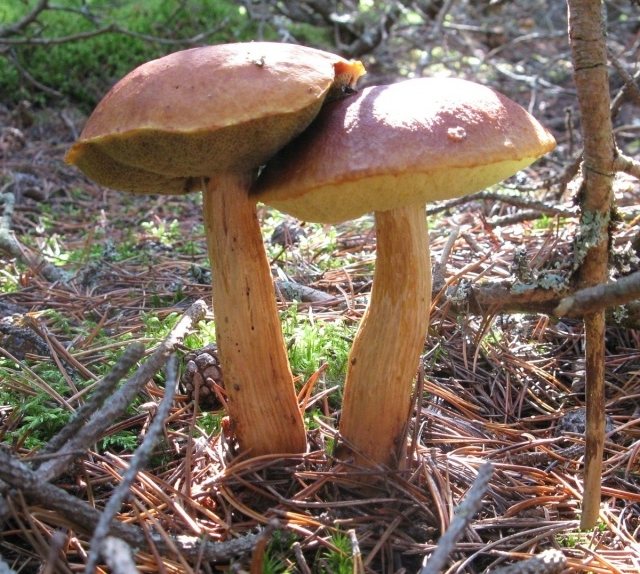
Royal
This southern European mushroom loves oak groves, differing from other members of the genus with a bright red cap with a velvety surface, which can sometimes acquire a pinkish or even deep purple hue. The leg, hymenophore and flesh of royal boletus have a uniform light yellow hue, and a pleasant taste allows not only frying and drying the fruits, but also preparing all kinds of marinades and pickles on their basis.

Bronze
Distinctive characteristics of this variety, which grows mainly in deciduous forests of the North American continent, is a dark brown cap, often reaching 17 cm in diameter, as well as a rather dark cylindrical or barrel-shaped stem with a reddish tint. At the break, the pulp does not change its color and does not emit milky juice.
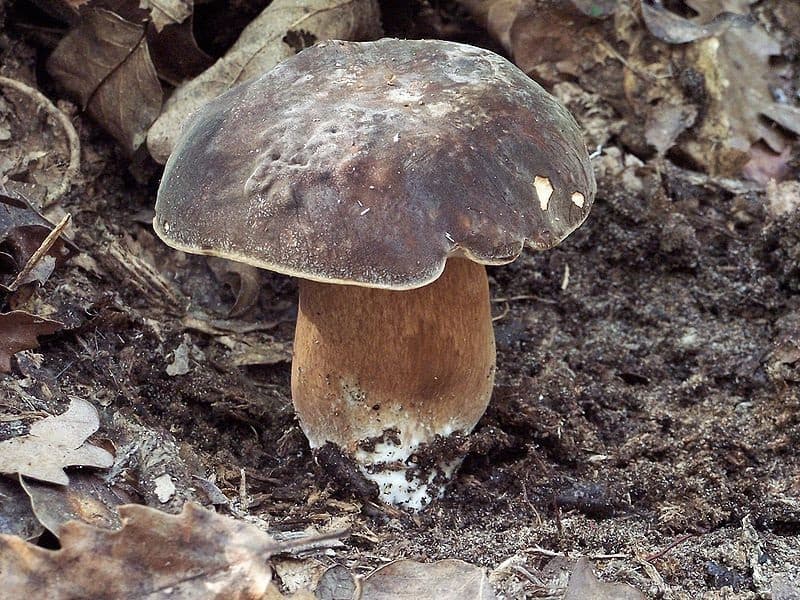
Bicolor
Quite a rare species of the family, found in the eastern part of the forests of North America.The main feature of the boletus is the uniform coloring of the fruiting body in red with a rich yellow tint at the break, which turns blue over time. The mushroom cap also has the ability to change, which, as it ages, departs from its convex shape, opening to the maximum.
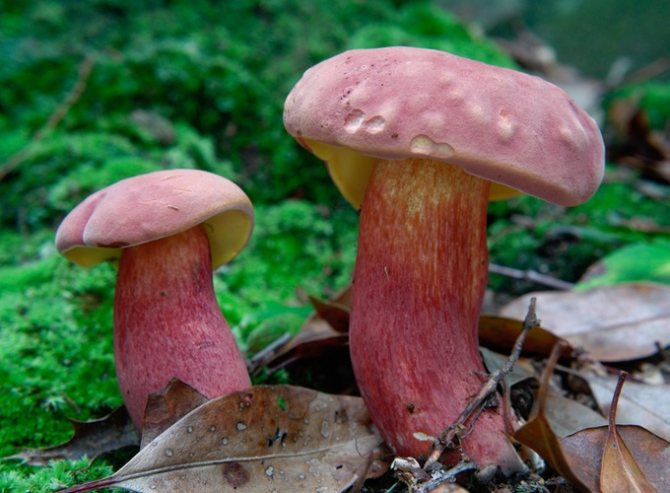
Growing boletus
Cultivation of boletus is a painstaking occupation that requires patience and special conditions. Due to its biological properties, the fungus needs a close connection with the root system of trees. For successful cultivation, it is necessary to plant spruce, pine or birch on the site, then you can start breeding boletus in any of three ways:
- Crushed boletus is soaked in water for a day, mixed and filtered. The finished infusion containing boletus spores is carefully distributed under the trees.
- Separate tracts of land containing mycelium are dug in the forest. Under the trees in the garden, small depressions are made in the soil, where the mycelium is placed and covered with forest soil. The mycelium needs moderate watering.
- The caps of overripe boletus are cut into small slices and mixed with moistened soil, and then laid out under the trees.
With timely watering for the next year, you can get a harvest: first, individual boletus, then whole families.

Poisonous, inedible and false boletus species
Inedible, but non-toxic species, are not capable of causing severe poisoning, but they have an unpleasant taste. Poisonous species are characterized by the presence of toxic substances that can provoke severe damage to internal organs and tissues.
Variety le Gal
Vol.légaliae is a poisonous species with a hemispherical, smooth, pinkish-orange cap, whitish or yellowish flesh that turns blue on the cut. The area of the leg is swollen, with a surface covered with a reddish mesh. Tubules with an adherent tooth and red pores. Spores are olive brown, fusiform.
Boletus purple
Vol.purpureus is a low-toxic, but inedible variety with a hemispherical, then convex cap with uneven edges, covered with a velvety, reddish-brown skin with rare blackish specks. The pulp is of a fleshy type, with a very high density, immediately blue, and then bright red when cut. The area of the leg is rather thick, clavate, covered with a dense reddish mesh pattern. The tubules are loose, golden yellow or olive. Spores with an olive tint.
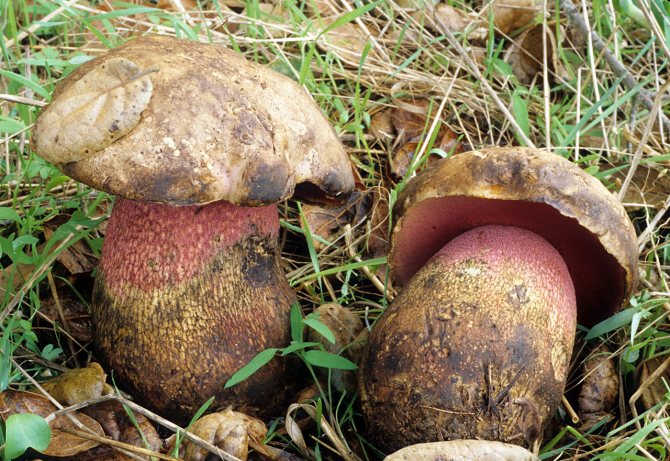
Boletus purple
Pink-skinned boletus
Vol.rhodokhanthus is a rare and poorly studied inedible variety that has a hemispherical, cushion-shaped, prostrate and slightly depressed cap in the central part, covered with a smooth or slightly velvety, sometimes slightly sticky, brownish-gray or dirty brownish-yellow skin with a characteristic tint ... The soft part with sufficient density, lemon-yellow in color, slightly blue in the cut, with a weak mushroom aroma and bitter taste. The stem is tuberous, often pointed at the very base, yellow in color, covered with a thin, bright red, rather convex mesh or looped pattern. The tubules are light yellow or bright beige-yellow. Olive spores.

Pink-skinned boletus
Bolet the Beautiful
Vol.рulcherrimus is a poisonous species with a hemispherical, woolly cap of a reddish or olive-brown color. The soft part is quite dense, yellow in color, clearly bluish in the cut. The area of the leg, swollen, is reddish-brown in color, with a dark reddish mesh. Tubules with an attached tooth, yellow-green, blood-red. The spores are brown, fusiform.
Rooting hurts
Vol.radisans - due to its bitter taste, the mushroom belongs to the category of inedible. It has a hemispherical or convex cap with a protruding leathery-type edging. The skin is whitish, off-gray or brownish-gray, woolly or cracked. The soft part is lemon-yellow in color, blue in the cut, with a light mushroom aroma and an unpleasant bitter taste.The stem is swollen, cylindrical, with a tuberous base, dull yellow or lemon yellow, with a thin, uniformly colored mesh pattern.
Types of boletus
The boletus genus includes about 300 species, many of which are edible and even delicious:
brown boletus (Boletus aereus
)
an edible mushroom with a bright brown, brown or almost black cap, up to 17 cm wide. The spherical cap at the beginning of growth becomes almost flat over time. This type of boletus grows in deciduous forests. The dense stem of the mushroom, in the shape of a barrel or cylinder, may be reddish in color. The pulp is white, does not change color. The mushroom grows from late spring to October in deciduous forests of European territory and in North America;

boletus (Boletus appendiculatus
)
an edible mushroom with a brownish-golden or reddish flat cap 7-20 cm wide. The lower part of the mesh leg is strongly pointed. The pulp is light yellow and has a bluish tint; it turns blue on the cut. This boletus grows in mixed European forests from early summer to October;

white oak mushroom, boletus
reticulate
(Boletus reticulatus
)
an edible mushroom with a large velvety cap up to 25 cm, which has a brown, brown or yellow color. A thick, fleshy, smooth leg of a young individual is covered with thin veins in maturity. Grows from May to mid-autumn in deciduous and mixed forests under beech, oak, chestnut, hornbeam;

white birch mushroom, or spikelet,
(Boletus betulicola
)
edible mushroom, diameter of the cap is 5-15 cm, the skin is smooth or slightly wrinkled, the flesh is white and does not change color when cut. The leg is barrel-shaped, has a whitish-brown color and a white mesh in the upper part;

boletus Burroughs
(Boletus barrowsii
)
edible mushroom. The cap is convex or flat, the flesh is white and does not change color when cut. The leg is white, clavate, with a whitish mesh. Grows in North America in deciduous and coniferous forests;

boletus bicolor
(Boletus bicolor
)
edible mushroom. The hat is pink-red in color, the flesh is yellow and blue at the cut. The leg is in the color of the cap. Grows in the eastern part of North America;
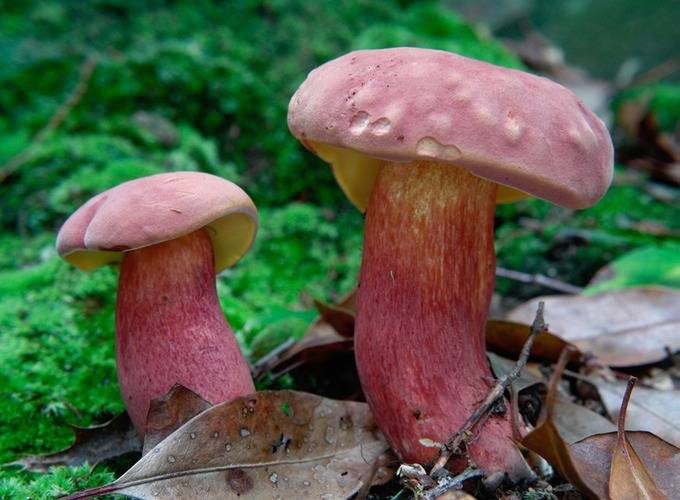
White mushroom
(Boletus edulis
)
edible mushroom. The diameter of the cap is 7-30 cm, usually convex. Skin color is from white to reddish brown. The pulp is white, turns yellow with age, does not change color when cut. The leg of the porcini mushroom is clavate or barrel-shaped, whitish or brownish in color;

Borovik Fechtner
(Boletus fechtneri
)
edible mushroom. The diameter of the cap is 5-15 cm. The pulp is white, it can turn blue in the air. The flesh of the leg may have a reddish tint. The leg is yellow, has a mesh;
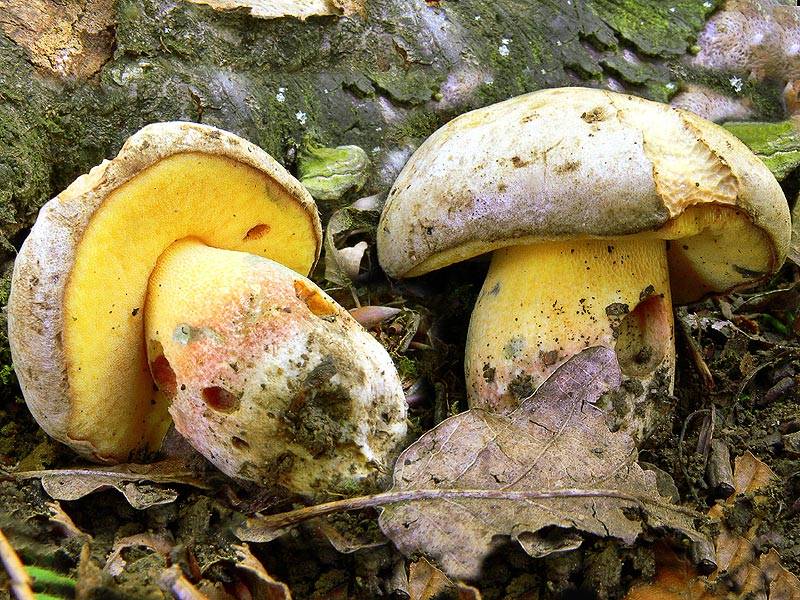
Semi-white mushroom, yellow stone
(Boletus impolitus
)
edible mushroom. The diameter of the cap is 5-15 cm. The flesh is white or light yellow. When cut, the color of the pulp does not change. The leg has a thickening at the bottom, rough to the touch. The top of the leg is straw-colored, the bottom of the leg may have a reddish tint.

What Fechtner's boletus look like
The mushroom belongs to the tubular group, that is, the back of the cap resembles a finely porous sponge of rich yellow color. In adult specimens, spore spots of an olive or rusty hue are clearly distinguishable. There are no remnants of the bedspread.
The diameter of the cap can be up to 30 cm
The upper part is smooth, with time it becomes slightly wrinkled. At high humidity, it becomes covered with a mucous layer. In dry weather - matte, pleasant to the touch.
The diameter of the cap is from 5 to 16 cm. In young mushrooms, it is rounded. As it grows, it becomes hemispherical, cushion, then flatter. Color: glossy silvery gray or pale brown.
The length of spore tubes in Boletus Fechtner is 1.5-2.5 cm
The flesh is white, dense, quickly turns blue when cut or broken.
The stem is tuberous, barrel-shaped or rounded. Over time, it becomes elongated cylindrical with a slight thickening downward. In height it reaches 12-14 cm, in volume - from 4 to 6 cm. Has a pale yellow, gray or slightly brownish color, sometimes acquires a reticular pattern. At the base, it may have a reddish-brown, brown, ocher color.On the cut - white or milky. Sometimes red streaks are visible.
Boletus maiden, or brown-yellow (Butyriboletus appendiculatus)
Edible mushrooms
Boletus girlish, or brown-yellow (lat.Butyriboletus appendiculatus) is an edible mushroom belonging to the genus Butyriboletus of the Boletaceae family. Until the 2010s, it was included in the genus Borovik (Boletus). Other names: sore brown-yellow, rooted boletus, reddish boletus, Ovary. Like all boletus mushrooms, this is a large and thick brownish mushroom. Boletus of this species can grow to very large sizes, there are individual specimens reaching 3 kg in weight. Boletus girlish is a rather rare species. In the Saratov region, it is noted in the Saratov and Khvalynsky districts. It is listed in the Red Book of the Saratov Region, protected on the territory of the Khvalynsky National Park. Usually grows on moist loamy or calcareous soils that are loose in structure, in floodplain oak forests, or in broad-leaved forests with a predominance of oak... Brown-yellow boletus is found on forest hills, slopes of wet ravines, in forest ditches. Boletus maiden prefers adult forest plantations, grows both singly and in small groups from 3 to 10 pcs. It has been noticed that they can often be found in those places where there are many red fly agarics. Forms mycorrhiza with oak trees... Fruiting bodies form at the end of June and bear fruit until the end of October, the abundance of fruiting depends on the amount of precipitation and varies significantly from year to year.
Boletus adnexa belongs to the first category of edibility, an edible mushroom with excellent nutritional characteristics. Recognized as an excellent edible mushroom. Boletus is eaten in all possible forms: fried, dried, boiled in soup, stewed, marinated, etc. Excellent taste makes it possible not to presoak or boil these mushrooms, it is suitable for drying. Boletus is a tasty and healthy mushroom, but it is not recommended to eat them for problems with digestion, pregnancy, lactation and a tendency to allergies. Also, you do not need to give mushrooms to small children, since their digestive tract still cannot cope with such heavy food.
The hat is 5 to 20 cm in diameter, hemispherical in youth, later cushion, yellow-brown, light brown or chestnut brown, with a sharp edge. Convex with slightly curved edges. The skin is thin, dry, tomentose-fluffy, fleshy. Tubular layer, adherent to the tooth, 1-2.5 cm thick, bright lemon-yellow color, turns brownish-yellow with age, turns blue when pressed. The pulp is dense, light yellow with a bluish tinge, turns blue on the cut, with a pleasant aroma.
The leg is dense, elongated, at a young age ovoid, then clavate or almost cylindrical, 5-15 x 1-6 cm, often has a growth resembling a root, golden yellow, then brownish, with a thin yellow fine mesh in the upper part, when pressed slightly blue.
Edible: This is a rather rare mushroom, but it has many similar mushrooms in appearance. It looks like Fechtner's ache (Boletus fechtneri) with a silvery-white or pale grayish-brownish cap and a royal pain (Boletus regius) with a pink or red cap. These three types are united by the bright yellow color of the hymenophore. A semi-white mushroom (Hemileccinum impolitum) is slightly lighter in color, has a characteristic odor of raw carbolic acid.
Inedible: Inedible boletus (Boletus calopus) has a more brightly colored leg, grows on acidic fertile soils. Root boletus (Boletus radicans) with a lighter colored cap, thickened leg.
Poisonous analogues are not observed in the boletus. Therefore, the only thing that can happen is picking a tasteless mushroom, which is certainly unpleasant, but does not threaten life and health.
Pink-purple
The shape and diameter of the cap are exactly the same as that of the previous representative of the Borovik genus. When wet, the cap becomes a little slimy and acquires tubercles.This mushroom has an irregular color that ranges from light gray to olive gray. Has areas with purplish red and brown tint. When pressed against the mushroom, dark blue spots are formed. Sometimes pink purple aches can damage insects. The damaged areas have a yellowish or olive-lemon tint.
Important! Note to mushroom pickers: anthills are often found in places where a large number of boletus grows.
The characteristics of the tubular layer and pores are the same as in the beautiful pain, however, the pores are brighter in color (pink-orange or light red). The length of the leg of this bolt reaches 15-17 cm, and its diameter is 7 cm. The color of the leg is lemon yellow with a slight pinkish-purple tint. At the end, it has a light burgundy mesh, when pressed, it takes on a blue tint.
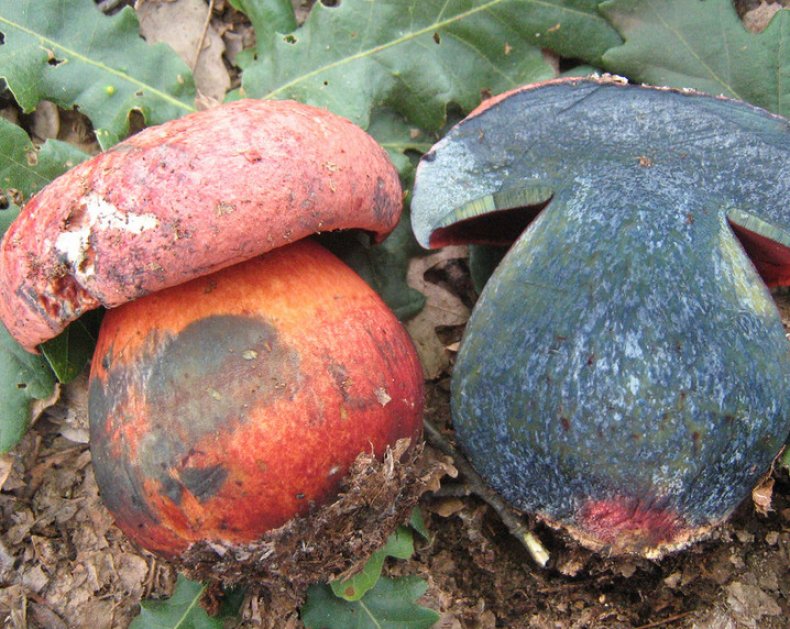
The pulp of this representative is dense, has a pleasant fruity smell, olive yellow color. At the cut site, it becomes dark blue, after a while the color becomes a contrasting wine shade. Pink-purple boletus has a sweet flesh and pleasant taste characteristics, but it is not recommended to use it raw or boiled, as it is a poisonous representative of pain.
Edible mushrooms include: red mushrooms, milk mushrooms, pig mushrooms, boletus mushrooms, mushrooms of the Russula family, flyworm and honey agarics
There is a pink-purple mushroom on calcareous soils, in deciduous forests, more often in mountainous regions. It prefers to grow among beeches and oaks. This pain has been little studied by mycologists, so it is not recommended to collect it. In addition, mushroom pickers rarely meet him. Most widespread in Western Ukraine, Russia, and some European countries.








